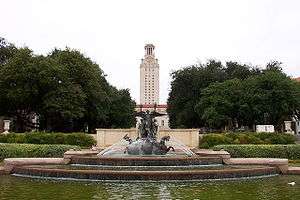Pompeo Coppini
| Pompeo Coppini | |
|---|---|
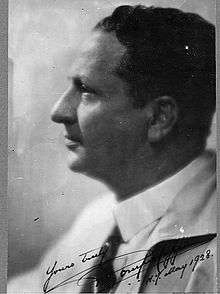 Pompeo Coppini 1929 | |
| Born |
Pompeo Luigo Coppini May 19, 1870 Moglia, Mantua, Italy |
| Died |
September 26, 1957 (aged 87) San Antonio, Texas |
| Nationality |
Italian born 1902 Naturalized AmericanUnited States citizen |
| Education |
Accademia dell'Arte del Disegno Augusto Rivalta |
| Known for | Sculpture |
| Notable work |
[1][2] Partial listing - Sculptures, except where noted Italy
Mexico
Kentucky
New Jersey
New York
Texas
|
| Website | Coppini Academy |
Pompeo Luigi Coppini (May 19, 1870 – September 26, 1957) was an Italian born sculptor who emigrated to the United States. Although his works can be found in Italy, Mexico and a number of American states, the majority of his work can be found in Texas. He is particularly famous for the Alamo Plaza work "Spirit of Sacrifice" aka The Alamo Cenotaph, as well as numerous statues honoring Texas heroes.
Early years
He was born in Moglia, Mantua, Italy, the son of musician Giovanni Coppini[18] and his wife Leandra (Raffa) Coppini.
The family moved to Florence where at the age of ten, Pompeo was hired to make ceramic horses shaped like whistles.[18] From there, he worked for a sculptor who made tourist knock-offs of great works of art. At age sixteen, he studied at Accademia dell'Arte del Disegno under Augusto Rivalta. Upon earning a degree, Coppini opened a short-lived studio making gratis busts of local celebrities. While working for a cemetery monument sculptor, Coppini tried to become co-owner of the business by courting the owner's daughter. The girl's mother balked, and the resulting situation got Coppini denounced[18] from a local priest's pulpit.
The United States
He emigrated to the United States in March, 1896 with nothing but a trunk of clothes and $40 to his name. Coppini got a job in New York sculpting figures[18] for a wax museum. Elizabeth di Barbieri of New Haven, Connecticut arrived, accompanied by a chaperone, to model for Coppini's memorial to Francis Scott Key. He fell in love[19] and married his model. Coppini became a United States citizen[2] in 1902.
While he managed to find work in New York, Coppini was frustrated the fame and greatness escaped him. He moved to Texas in 1901, to join with Germany-born sculptor [20] Frank Teich. He was then commissioned to do the figures for the Confederate monument for the state capitol grounds. For the next fifteen years, he lived and worked in San Antonio. After spending a short time in Chicago, Illinois, he then spent three years in New York City overseeing the Littlefield commission for the University of Texas at Austin. He collaborated with architect Paul Cret on the Littlefield Memorial Fountain, and sculpted six statues for the campus.

By 1910, Coppini was assisted by sculptor Waldine Tauch,[21] who had been born in Schulenburg, Texas. Tauch became more-or-less his adopted daughter, student and protégée, and he, after extracting a promise from her that she would never marry, molded her into a devotee of classical sculpture. She collaborated with Coppini until his death.[22]
The William P. Rogers chapter of the United Daughters of the Confederacy raised $5,000[16][17] in 1911 and commissioned Coppini to design and erect the 1912 Confederate soldier memorial statue named "Last Stand", aka "Firing Line", in De Leon Plaza, Hiring Otto Zirkel of near the San Antonio studio to build the stone portion of the monument.
He sculpted three distinct statues of George Washington. The first, commissioned by Americans living in Mexico to commemorate the 1910 centennial of Mexican Independence, was installed in 1912 in the Plaza Dinamarca (renamed Plaza Washington) of the Colonia Juárez section of Mexico City. The Mexican Civil War was just beginning. Two years later, in reaction to the April 1914 United States invasion of Veracruz, the statue was toppled from its pedestal and dragged through the streets.[23] The second statue was created to commemorate the 1926 sesquicentennial of the Declaration of Independence. It was installed in 1927 in Portland, Oregon.[24] The third statue was commissioned by the Texas Society, Daughters of the American Revolution to commemorate the 1932 bicentennial of Washington's birth. Fund-raising problems delayed the project for years, and it was installed in February 1955 on the campus of the University of Texas at Austin.[25]
In 1931, Italy decorated Coppini with the Commendatore of the Order of the Crown of Italy for his contribution to art in America. The Texas Centennial Committee awarded Coppini the 1934 commission to design the [26]Texas Centennial Half Dollar. In 1937, Coppini opened his San Antonio studio on Melrose Place, in order to work on what would become the [15][27]Spirit of Sacrifice (aka The Cenotaph) at Alamo Plaza. Baylor University awarded Coppini an honorary doctor of fine arts degree in 1941. From 1943 to 1945 he was head of the art department of Trinity University in San Antonio. In 1945 he and Tauch cofounded the Classic Arts Fraternity in San Antonio (renamed Coppini Academy of Fine Arts in 1950).
Many of his works are in Austin, Texas, displayed on the grounds of the Texas State Capitol and on the campus of The University of Texas. Coppini's statue of Lawrence Sullivan Ross, Texas Governor and third president of Texas A&M University is considered one of the most revered works on the A&M campus in College Station and students often place coins at the statue's feet for good luck on exams. Coppini's marble statue of Senator James Paul Clarke stands in the U.S. Capitol. Coppini also designed two bronze sculptures at Baylor University in Waco, Texas—those of former Baylor University President Rufus C. Burleson, located on the Burleson Quadrangle on the Baylor campus (1905), and Baylor University namesake and founder Judge R.E.B. Baylor (1939). One of Coppini's best works, as stated by the artist, is the bronze sculpture of John Reagan, former U.S. Senator from Palestine, Texas, located in that city's Reagan Park (1911), featuring the personification of the "Lost Cause of the Confederacy" seated at the base of the monument.
Coppini died in San Antonio on September 26, 1957. He designed his own crypt[28] for his final resting place in Sunset Memorial Park.
Selected works
- Jefferson Davis (1901–03), Confederate Monument, Texas State Capitol, Austin, Texas.
- Confederate Monument (1903), Paris, Texas:
- Bust of Jefferson Davis.
- Bust of Robert E. Lee.
- Bust of Stonewall Jackson.
- Bust of Albert Sidney Johnston.
- Rufus C. Burleson (1903), Burleson Quadrangle, Baylor University, Waco, Texas.
- The Victims of the Galveston Flood (1903–04), University of Texas at Austin.
- Monument to Terry's Texas Rangers (1905–07), Texas State Capitol, Austin, Texas.
- Hood's Texas Brigade Monument (1910), Texas State Capitol, Austin.
- Come and Take It Monument (1910), Gonzales, Texas.
- Sam Houston Grave Monument (1910–11), Huntsville, Texas.
- John Hunt Morgan Memorial (1911), (former) Fayette County Courthouse, Lexington, Kentucky.
- John H. Reagan Memorial (1911), Palestine, Texas.
- George Washington (1911–12), Mexico City, Mexico.
- Confederate Monument (1911–12), Deleon Plaza, Victoria, Texas.
- Bust of William Rufus Shafter, (1919), Galesburg, Michigan,[29]
- Lawrence Sullivan Ross (1917–19), Texas A&M University, College Station, Texas.
- The Spirit of the Texas Cowboy (1918–19), Charles H. Noyes Memorial, Ballinger, Texas.
- George W. Littlefield Commission (1920–28), University of Texas at Austin:
- Littlefield Memorial Fountain, Paul Cret, architect. A World War I Memorial.
- John H. Reagan.
- Robert E. Lee.
- Albert Sidney Johnston.
- James Stephen Hogg.
- Jefferson Davis.
- Woodrow Wilson.
- Senator James Paul Clark of Arkansas (1921), National Statuary Hall Collection, United States Capitol, Washington, DC.
- Bronze doors (1926), Scottish Rite Cathedral (Masonic), San Antonio, Texas.
- George Washington (1926–27), Friendship Masonic Lodge 160, Portland, Oregon.
- Texas State Fair Hall of State (1935–36), Fair Park, Dallas, Texas:
- Stephen F. Austin.
- Thomas J. Rusk.
- William B. Travis.
- James W. Fannin.
- Mirabeau B. Lamar.
- Sam Houston.
- Cenotaph to the Heroes of the Alamo (1937–38), Alamo Plaza, San Antonio, Texas.
- Coppini Tomb (1953), Sunset Memorial Park, San Antonio, Texas.
- George Washington (1955), University of Texas at Austin.
Gallery
 Rufus Burleson (1903), Baylor University, Waco, Texas.
Rufus Burleson (1903), Baylor University, Waco, Texas.- Monument to Terry's Texas Rangers (1905–07), Texas State Capitol.
- Hood's Texas Brigade Monument (1910), Texas State Capitol.
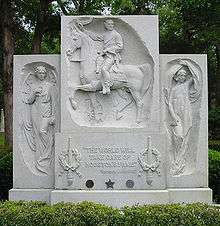 Sam Houston Grave Monument (1910–11), Huntsville, Texas.
Sam Houston Grave Monument (1910–11), Huntsville, Texas.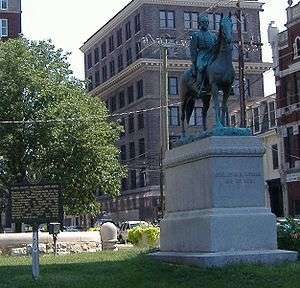 John Hunt Morgan Memorial (1911), Lexington, Kentucky.
John Hunt Morgan Memorial (1911), Lexington, Kentucky.- Confederate Monument (1911–12), Victoria, Texas.
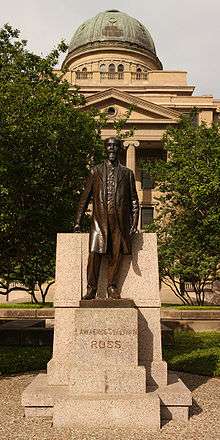 Lawrence Sullivan Ross (1917–19), Texas A&M University.
Lawrence Sullivan Ross (1917–19), Texas A&M University. General William Rufus Shafter (1919), Galesburg, Michigan.
General William Rufus Shafter (1919), Galesburg, Michigan. James Paul Clark (1921), United States Capitol, Washington, DC.
James Paul Clark (1921), United States Capitol, Washington, DC. Stephen F. Austin and Sam Houston (1935–36), Hall of State, Dallas, Texas.
Stephen F. Austin and Sam Houston (1935–36), Hall of State, Dallas, Texas. Alamo Cenotaph (1937–38), San Antonio, Texas.
Alamo Cenotaph (1937–38), San Antonio, Texas.
Additional reading
- Cantrell, Gregg; Turner, Elizabeth Hayes; Brundage, Fitzhugh (2006). Lone Star Pasts: Memory and History in Texas. TAMU Press. ISBN 978-1-58544-563-9.
- Little, Carol Morris (1996). A Comprehensive Guide to Outdoor Sculpture in Texas. University of Texas Press. ISBN 978-0-292-76034-9.
- Wright, John R (1989). Pompeo Coppini and Corpus Christi's first experiment with public art. J.R. Wright. ASIN: B00072X84Q.
- Delaplaine, Edward S (1987). Doyle and Coppini: Sculptors of the Francis Scott Key monument. Frederick News-Post. ASIN: B00073BYFA.
- Coppini, Pompeo (1949). From Dawn to Sunset. The Naylor Company. ASIN: B000ONFTT0.
References
- ↑ "Partial Listing Pompei Works". Coppini Academy. Retrieved 15 June 2010.
- 1 2 Troesser, John. "Coppini's Work in Texas". Texas Escapes - Blueprints For Travel, LLC. Retrieved 15 June 2010.
- ↑ "Foreign News". The Bryan Times. 26 November 1976.
- ↑ Matthews, Gary R (2005). Basil Wilson Duke, CSA: The Right Man in the Right Place. The University Press of Kentucky. p. 302. ISBN 978-0-8131-2375-2.
- ↑ "Outdoor Art Inspirations" (PDF). City of Grand Rapids Downtown Development Authority. Retrieved 16 June 2010.
- ↑ "State Briefs". Ludington Daily News. 14 June 1025.
- ↑ "John Ball Statue, Grand Rapids Michigan". Free4AllCity, LLC. Retrieved 16 June 2010.
- ↑ Little, Carol Morris (1996). A Comprehensive Guide to Outdoor Sculpture in Texas. University of Texas Press. pp. 61–62. ISBN 978-0-292-76034-9.
- ↑ Nicar, Jim (May–June 2001). "Symbolism Amok". The Alcalde: 79–80.
- ↑ "Woodrow Wilson Statue". The Polk County News. 6 March 1924.
- ↑ Wolff Jr., Henry (30 September 2001). "Come and Take It Skirmish was Significant". The Victoria Advocate.
- ↑ "Sam Houston, Texan". Bluffton Chronicle. 27 October 1909.
- ↑ State Historical Commission. "Texas Historical Marker, Scottish Rite Cathedral". Retrieved 16 June 2010.
- ↑ "Capstone Reunion of Scottish Rites Bodies November 15". The Victoria Advocate. 9 November 1926.
- 1 2 "Coppini, Commentator". The Rotarian: 47. October 1939.
- 1 2 Jones, Martha (4 September 1999). "History of De Leon Plaza is a Rich One". The Victoria News.
- 1 2 Wolff Jr, Henry (10 July 2002). "Day of Southern, US Pride in Victoria". The Victoria Advocate.
- 1 2 3 4 Harrigan, Stephen (October 1984). "Coppini the Great". Texas Monthly.
- ↑ Pompeo Coppini from the Handbook of Texas Online. Retrieved 16 June 2010. Texas State Historical Association
- ↑ Frank Teich from the Handbook of Texas Online. Retrieved 16 June 2010. Texas State Historical Association
- ↑ Curlee, Kendall: Waldine Tauch from the Handbook of Texas Online. Retrieved 16 June 2010. Texas State Historical Association
- ↑ Hutson, Alice, ‘’From Chalk to Bronze: A Biography of Waldine Tauch,’’ Shoal Creek Publishers, Austin, TX 1978
- ↑ Plaza Washington in 1914 from Getty Images.
- ↑ Portland, Oregon Washington from SIRIS.
- ↑ Austin, Texas Washington from SIRIS.
- ↑ "Texas Centennial Half Dollar". U.S. Rare Coin Investments. Retrieved 16 June 2010.
- ↑ Troesser, John. "The Spirit of Sacrifice aka The Alamo Cenotaph". Texas Escapes - Blueprints For Travel, LLC. Retrieved 16 June 2010.
- ↑ "Final Resting Place Pompeo Coppini". Find A Grave. Retrieved 16 June 2010.
- ↑ Hendry, Fay, photos by Balthazar Korab, ‘’Outdoor Sculpture of Kalamazoo’’, iota press, Okemos, MI, 1980 pp. 64–65
External links
| Wikimedia Commons has media related to Pompeo Coppini. |
- Coppini Academy at his former workshop
- Pompeo Coppini from the Handbook of Texas Online
- Pompeo Coppini at Find a Grave
- Texas State Preservation Board: Texas State Capitol Monuments
- The University of Texas at Austin: Tour: Statues
- Texas A&M University: Outdoor Sculpture
